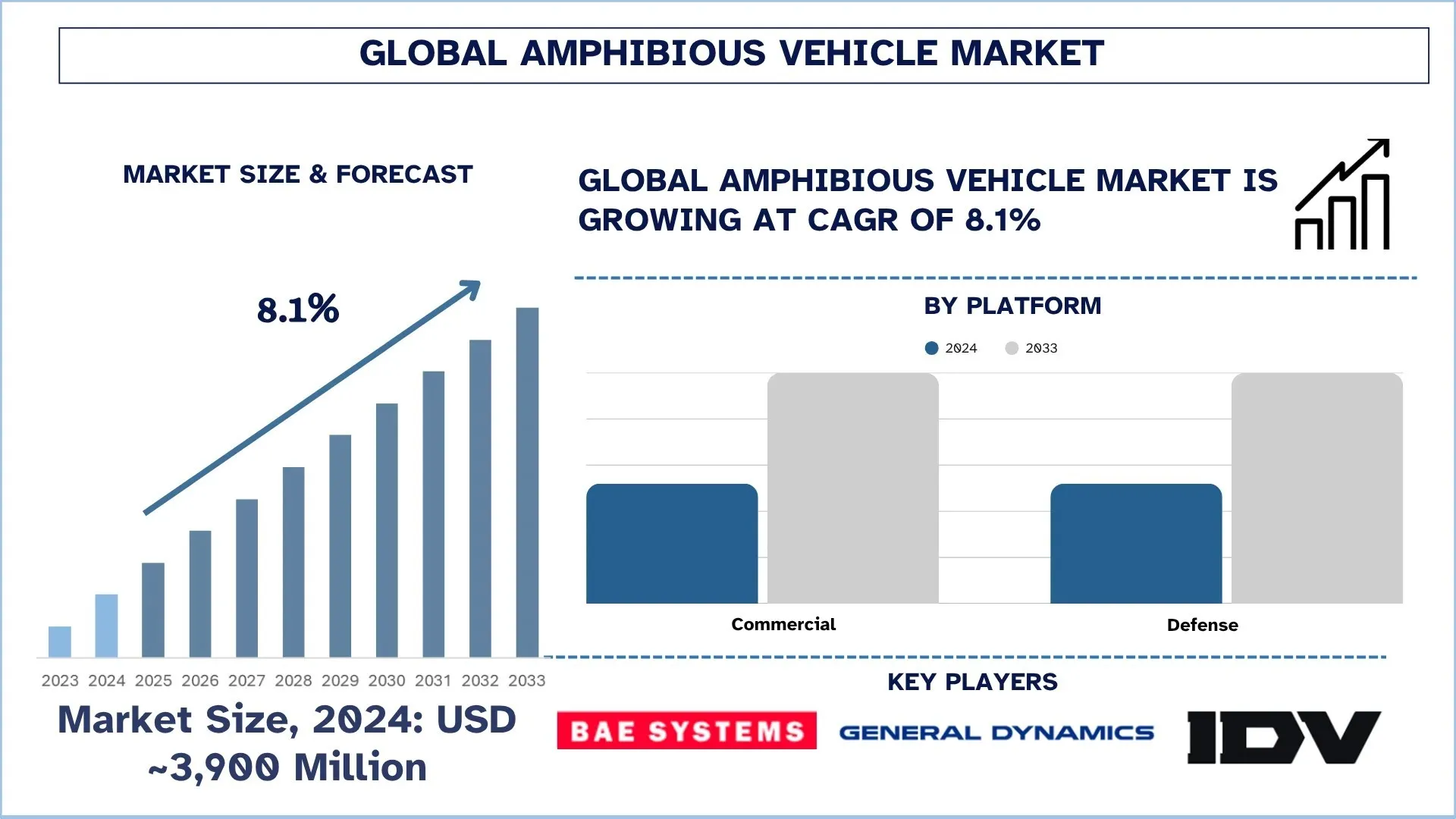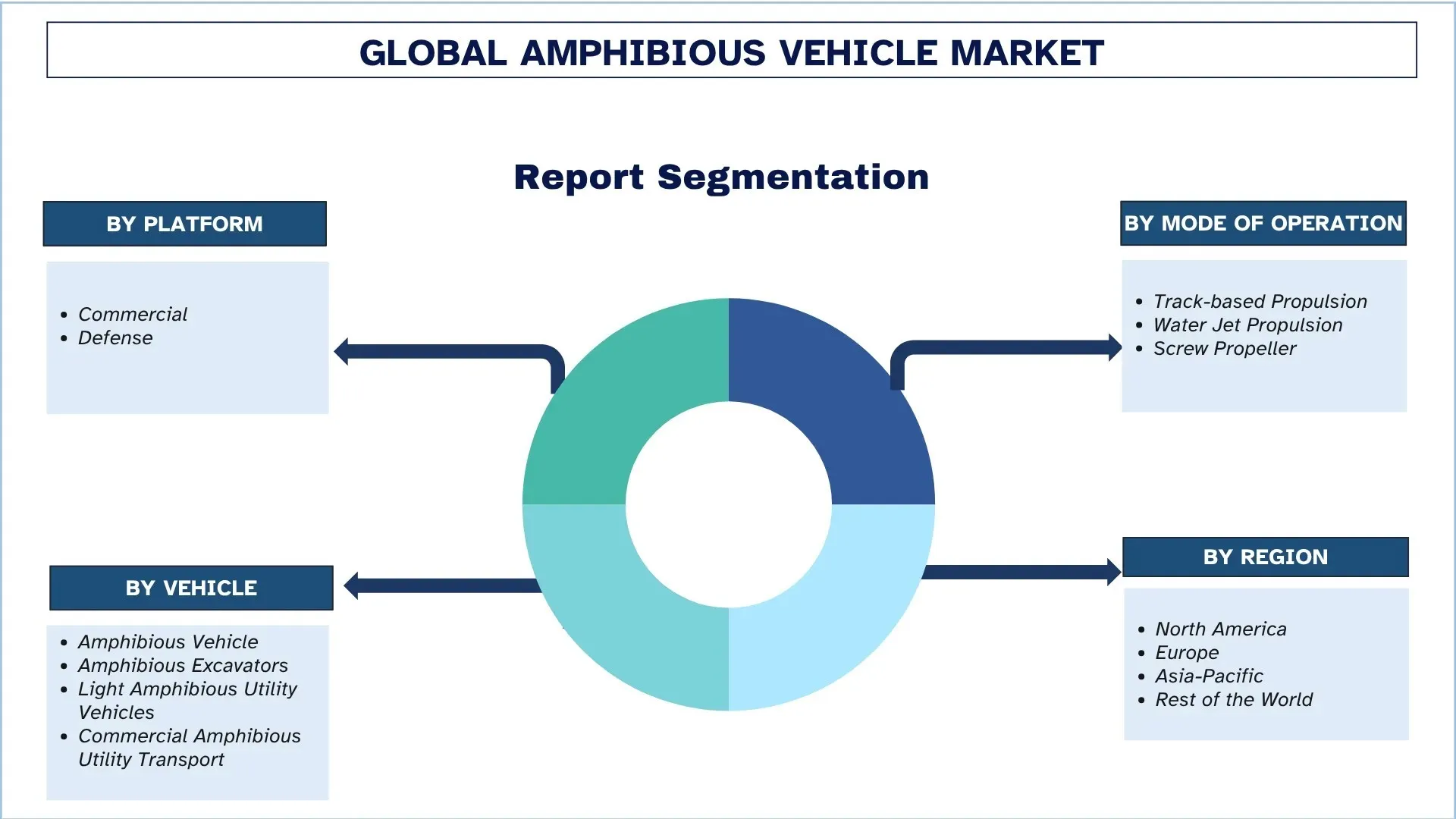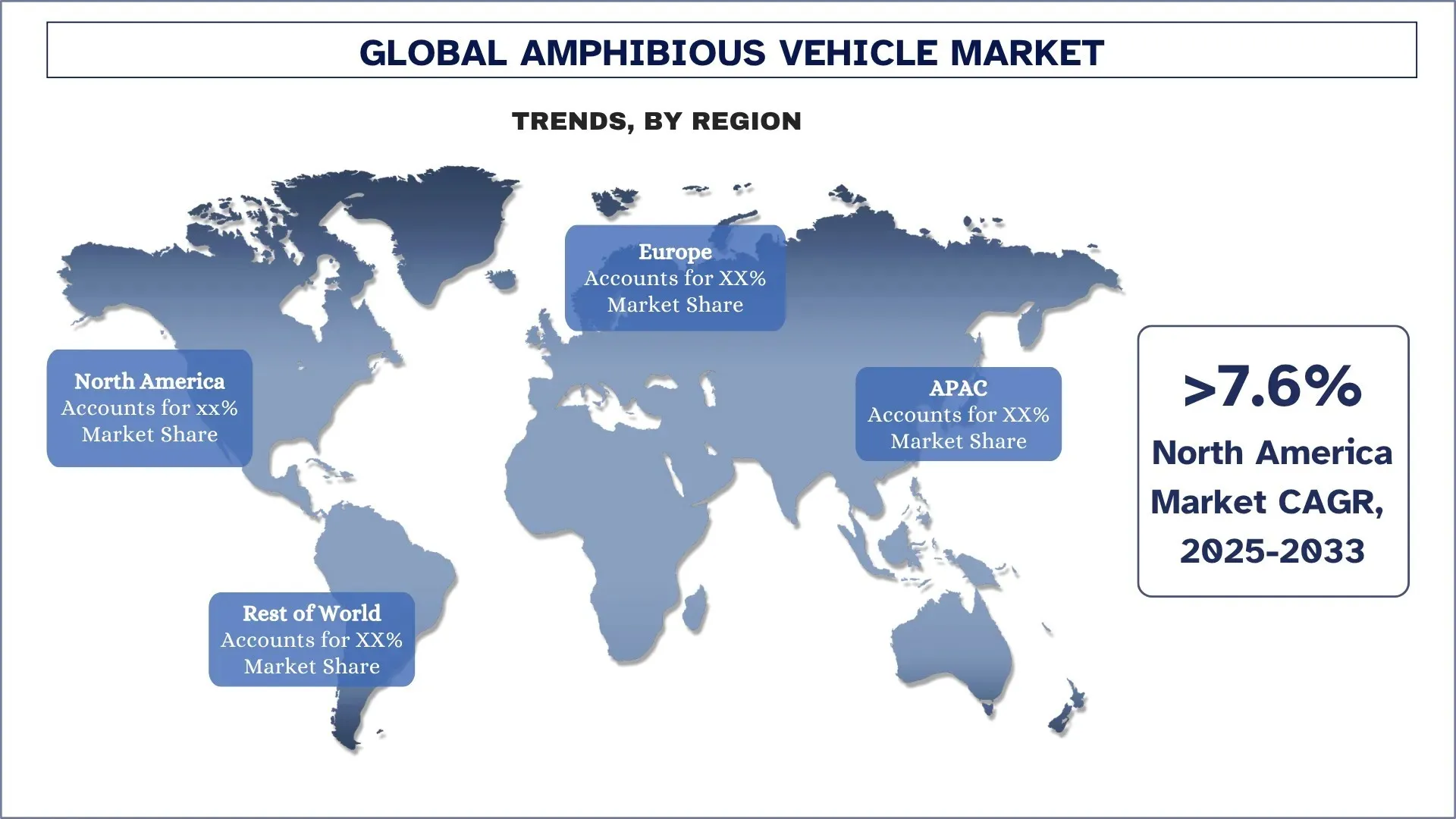- Home
- About Us
- Industry
- Services
- Reading
- Contact Us
Amphibious Vehicle Market: Current Analysis and Forecast (2025-2033)
Emphasis On Platform (Commercial, and Defense), By Mode of Operation (Track-Based Propulsion, Water Jet Propulsion, and Screw Propeller), By Vehicle (Amphibious Vehicle, Amphibious Excavators, Light Amphibious Utility Vehicles, and Commercial Amphibious Utility Vehicles) and Region/Country

Global Amphibious Vehicle Market Size & Forecast
The global Amphibious Vehicle Market was valued at USD 3,900 million in 2024 and is expected to grow to a strong CAGR of around 8.1% during the forecast period (2025-2033F), owing to the rising application in commercial and military sectors.
Amphibious Vehicle Market Analysis
The global amphibious vehicle market has shown significant market growth during historical years. With the rising military expenditure as well as the commercial application rise of amphibious vehicles across countries, these are some of the key factors contributing to the market rise. Furthermore, rising trends such as the integration of advanced technologies and multi-role amphibious vehicles would also be some of the key factors that would be crucial for the expansion of the market. In line with this, many of the companies have announced their plans to launch new-age amphibious vehicles.
Global Amphibious Vehicle Market Trends
This section discusses the key market trends that are influencing the various segments of the global Amphibious Vehicle market, as found by our team of research experts.
Integration of Advanced Technologies:
Amphibious vehicles are now experiencing a revolution as engineers continue to add new systems to the vehicles for augmented performance, safety, and adaptability. Contemporary vehicles will very often be equipped with GPS navigation, onboard diagnostics, and communication systems with an AI component to enable real-time decision-making. Automation is gaining significant importance in industries such as defense and search-and-rescue sectors, which reduces human exposure to danger and produces higher efficiency with autonomous or semi-autonomous capabilities. On the other hand, sensor fusion will fuse sonar, radar, and visual data to enhance land and water terrain consciousness and obstacle avoidance. They are also receiving advantages from state-of-the-art lightweight composite materials, whereby the vehicles can save on fuel efficiency and buoyancy while guaranteeing durability. As the request for multi-purpose vehicles grows bigger, especially in military and disaster-response areas, smart technologies have thus come to take center stage in differentiating products. Thus, a manufacturer willing to spend heavily on R&D to foster these capabilities will likely be best positioned to ride these waves of change.
Amphibious Vehicle Industry Segmentation:
This section provides an analysis of the key trends in each segment of the global Amphibious Vehicle market report, along with forecasts at the global, regional, and country levels for 2025-2033.
The Defense Category has shown promising growth in the Amphibious Vehicle Market.
Based on the platform, the global amphibious vehicle market is bifurcated into commercial and defense. Of these the defense sector has held the major market share due to high demand for amphibious vehicles. These amphibious vehicles are extensively used in combat and rescue operations in sensitive regions where the troops require an additional layer of protection. These vehicles can easily travel in marshy areas where troop mobility is difficult for other vehicles. Considering the robust applicability in transportation, many of the militaries across the globe are investing in order to integrate more amphibious vehicles.
Track-based Propulsion Category Dominates the Amphibious Vehicle Market.
Based on Mode of Operation, the market is divided into track-based propulsion, water jet propulsion, and screw propeller. Of these, the track-based propulsion category has held the major market share. Some of the key factors contributing to growth are enhanced mobility in different terrains, better grip, and rugged build, making them easy to operable in uneven terrains. Additionally, tracks enable these vehicles to easily traverse through mud and marshy areas, which makes them highly versatile for the military as well as commercial applications.
Amphibious Vehicle Category Dominates the Amphibious Vehicle Market.
Based on vehicles, the market is segmented into amphibious vehicles, amphibious excavators, light amphibious utility vehicles, and commercial amphibious utility vehicles. Of these, amphibious vehicles have held a sizeable market share. This dominance is largely driven by their extensive use in military and defense operations, particularly for troop transportation, reconnaissance missions, and logistical support during amphibious assaults.

North America is expected to grow at a considerable rate during the forecast period.
North America has held a major market share in the amphibious vehicle market. North America is home to some of the leading militaries in the world as the USA, China, etc. These countries fall in the top list of major defense spenders and procurers. Furthermore, the disaster management and rapid response to evacuation are also one of major reasons why a large number of commercial and defense forces procure amphibious vehicles. Additionally, the mining activities in the countries are also on the higher side, due to which the demand for amphibious excavators is extensively being used. In 2025, Roshel signed an agreement with the Singapore-based ST’s Engineering for the production of an amphibious all-terrain vehicle in Canada. The vehicle named Extreme V is a key candidate for the replacement of Canada’s Domestic Arctic Mobility Enhancement Program for replacing the legacy BV206 fleet for emergency response teams.
The US is expected to grow at a considerable rate during the forecast period.
The amphibious vehicle market is again seeing momentum in 2025 due to defense upgrades and climate resilience needs. The U.S. Marine Corps is finalizing the acquisition of a new ACV fleet to replace the aged AAVs and to support modern amphibious operations. Simultaneously, demand from emergency response agencies and private companies is rising due to increased flooding and shoreline erosion. In the non-defense market, the civilian interests of tourism and remote access solutions are also expanding. The technologies, especially those involving electric propulsion, modular hulls, and autonomous navigation, are providing this category of vehicles with versatility in cost and ability for adaptive environmental interaction across several operational domains.

Amphibious Vehicle Industry Competitive Landscape:
The global Amphibious Vehicle market is competitive, with several global and international market players. The key players are adopting different growth strategies to enhance their market presence, such as partnerships, agreements, collaborations, new product launches, geographical expansions, and mergers and acquisitions.
Top Amphibious Vehicle Companies
Some of the major players in the market are BAE Systems Plc., Elk Engineering Sdn. Bhd., General Dynamics Corporation, Griffon Hoverwork Ltd., Iveco Defence Vehicles, Lockheed Martin Corporation, Wetland Equipment Company Inc., Rheinmetall AG, Wilson Marsh Equipment Company, and SHERP.
Recent Developments in the Amphibious Vehicle Market
In 2023, the Italian navy ordered 36 IDV amphibious vehicles. The Directorate of Land Armaments of Italy signed a contract with IDV for the supply of 36 new Amphibious Armored vehicles. The VBA is an 8×8 all-terrain vehicle, capable of being launched and recovered from an amphibious vessel in open ocean and offering a high degree of ballistic, IED, and anti-mine protection.
In 2024, BAE delivered its new ACV-30 amphibious combat vehicles to the US Marine Corps. The vehicles are delivered under the Advanced Combat Vehicle (ACV) program. According to the company, 70 ACVs were delivered in the year 2023.
Global Amphibious Vehicle Market Report Coverage
Details | |
Base year | 2024 |
Forecast period | 2025-2033 |
Growth momentum | Accelerate at a CAGR of 8.1% |
Market size 2024 | USD 3,900 Million |
Regional analysis | North America, Europe, APAC, Rest of the World |
Major contributing region | North America is expected to dominate the market during the forecast period. |
Key countries covered | U.S., Canada, Germany, U.K., Spain, Italy, France, China, Japan, South Korea, and India |
Companies profiled | BAE Systems Plc., Elk Engineering Sdn. Bhd., General Dynamics Corporation, Griffon Hoverwork Ltd., Iveco Defence Vehicles, Lockheed Martin Corporation, Wetland Equipment Company Inc., Rheinmetall AG, Wilson Marsh Equipment Company, and SHERP. |
Report Scope | Market Trends, Drivers, and Restraints; Revenue Estimation and Forecast; Segmentation Analysis; Demand and Supply Side Analysis; Competitive Landscape; Company Profiling |
Segments Covered | by Platform, by Mode of Operation, by Vehicle, by Region/Country |
Reasons to Buy the Amphibious Vehicle Market Report:
The study includes market sizing and forecasting analysis confirmed by authenticated key industry experts.
The report briefly reviews overall industry performance at a glance.
The report covers an in-depth analysis of prominent industry peers, primarily focusing on key business financials, type portfolios, expansion strategies, and recent developments.
Detailed examination of drivers, restraints, key trends, and opportunities prevailing in the industry.
The study comprehensively covers the market across different segments.
Deep dive regional-level analysis of the industry.
Customization Options:
The global Amphibious Vehicle market can further be customized as per the requirements or any other market segment. Besides this, UnivDatos understands that you may have your own business needs; hence, feel free to contact us to get a report that completely suits your requirements.
Table of Content
Research Methodology for the Global Amphibious Vehicle Market Analysis (2023-2033)
We analyzed the historical market, estimated the current market, and forecasted the future market of the global Amphibious Vehicle market to assess its application in major regions worldwide. We conducted exhaustive secondary research to gather historical market data and estimate the current market size. To validate these insights, we carefully reviewed numerous findings and assumptions. Additionally, we conducted in-depth primary interviews with industry experts across the Amphibious Vehicle value chain. After validating market figures through these interviews, we used both top-down and bottom-up approaches to forecast the overall market size. We then employed market breakdown and data triangulation methods to estimate and analyze the market size of industry segments and sub-segments.
Market Engineering
We employed the data triangulation technique to finalize the overall market estimation and derive precise statistical numbers for each segment and sub-segment of the global Amphibious Vehicle market. We split the data into several segments and sub-segments by analyzing various parameters and trends, by Platform, by Mode of Operation, by Vehicle, and by regions within the global Amphibious Vehicle market.
The Main Objective of the Global Amphibious Vehicle Market Study
The study identifies current and future trends in the global Amphibious Vehicle market, providing strategic insights for investors. It highlights regional market attractiveness, enabling industry participants to tap into untapped markets and gain a first-mover advantage. Other quantitative goals of the studies include:
- Market Size Analysis: Assess the current forecast and market size of the global Amphibious Vehicle market and its segments in terms of value (USD).
- Amphibious Vehicle Market Segmentation: Segments in the study include areas by Platform, by Mode of Operation, by Vehicle, and by
- Regulatory Framework & Value Chain Analysis: Examine the regulatory framework, value chain, customer behavior, and competitive landscape of the Amphibious Vehicle industry.
- Regional Analysis: Conduct a detailed regional analysis for key areas such as Asia Pacific, Europe, North America, and the Rest of the World.
- Company Profiles & Growth Strategies: Company profiles of the Amphibious Vehicle market and the growth strategies adopted by the market players to sustain in the fast-growing market.
Frequently Asked Questions FAQs
Q1: What is the global Amphibious Vehicle market’s current market size and growth potential?
The global Amphibious Vehicle market was valued at USD 3,900 Million in 2024 and is expected to grow at a CAGR of 8.1% during the forecast period (2025-2033).
Q2: Which segment has the largest share of the global Amphibious Vehicle market by Platform?
The defense sector has held the major market share due to high demand for amphibious vehicles. These amphibious vehicles are extensively used in combat and rescue operations in sensitive regions.
Q3: What are the driving factors for the growth of the global Amphibious Vehicle market?
• Increased Use in Disaster Relief and Rescue Operations: Amphibious vehicles are witnessing heightened deployment in emergency response and disaster relief operations, owing to their ability to traverse both land and water seamlessly. Following the spikes in natural calamities like flooding, hurricanes, and tsunamis, amphibious vehicles form an important link in the mobility chain where traditional modes fail.
• Growth in Marine Tourism and Commercial Applications: Expanding marine-based recreation and coastal commercial activities have brought amphibious vehicles into the spotlight. Tourism operators promote amphibious tours as a distinctive sight within coastal cities, island resorts, and national parks, which stands as an incentive for vehicle demand in the leisure sector.
Q4: What are the emerging technologies and trends in the global Amphibious Vehicle market?
• Integration of Advanced Technologies: Amphibious vehicles are now experiencing a revolution as engineers continue to add new systems to the vehicles for augmented performance, safety, and adaptability.
• Development of Multi-role Hybrid Vehicles: The global push for versatility in vehicle design brings the adoption of multi-role-hybrid amphibious vehicles among the leading militaries that can smoothly traverse terrains.
Q5: What are the key challenges in the global Amphibious Vehicle market?
• High Development and Maintenance Costs: Amphibious vehicles require specialized engineering to operate efficiently on both land and water, resulting in high production and maintenance costs. For many organizations, especially in developing regions, the financial burden of procurement, customization, and long-term operation poses a major barrier to adoption.
• Stringent Regulatory and Safety Requirements: Amphibious vehicles are subject to overlapping safety regulations from both automotive and maritime authorities. Ensuring compliance with emissions, watercraft operation, and road safety standards across different countries can delay deployments and increase certification costs.
Q6: Which region dominates the global Amphibious Vehicle market?
The North America region dominates the global Amphibious Vehicle market due to the rising demand for commercial and military sectors.
Q7: Who are the key players in the global Amphibious Vehicle market?
Some of the top Amphibious Vehicle companies include:
• BAE Systems Plc.
• Elk Engineering Sdn. Bhd.
• General Dynamics Corporation
• Griffon Hoverwork Ltd.
• Iveco Defence Vehicles
• Lockheed Martin Corporation
• Wetland Equipment Company Inc.
• Rheinmetall AG
• Wilson Marsh Equipment Company
• SHERP
Q8: How can stakeholders navigate technological advancements in the Amphibious Vehicle market?
Stakeholders can navigate technological advancements in the amphibious vehicle market by investing in R&D, fostering collaborations with tech providers, and adopting modular, upgradable platforms. Staying aligned with defense and commercial needs, while integrating smart systems and sustainability-focused innovations, ensures long-term competitiveness and adaptability in evolving operational environments.
Related Reports
Customers who bought this item also bought










